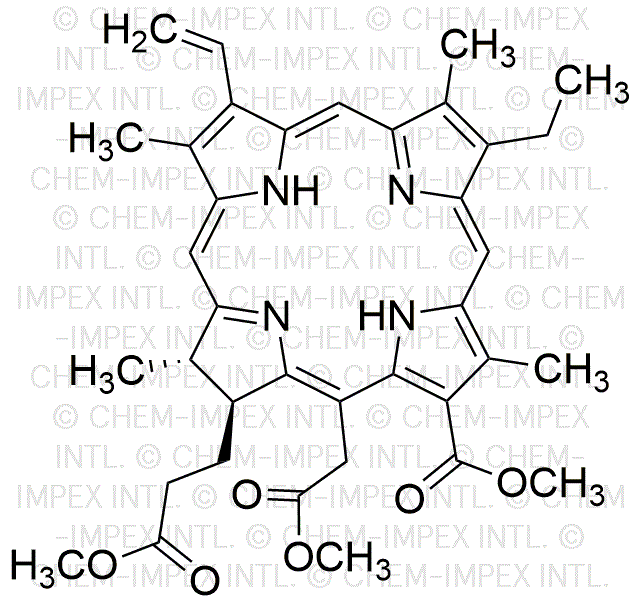Chlorin e6 trimethyl ester is widely utilized in research focused on:
- Photodynamic Therapy (PDT): This compound is effective in treating various cancers by generating reactive oxygen species upon light activation, leading to targeted cell destruction.
- Biomedical Imaging: Its unique optical properties make it suitable for enhancing contrast in imaging techniques, such as fluorescence imaging, aiding in the visualization of tumors.
- Solar Energy Conversion: Chlorin e6 trimethyl ester can be used in organic solar cells, improving light absorption and energy conversion efficiency compared to traditional materials.
- Antimicrobial Applications: The compound exhibits strong antimicrobial activity, making it valuable in developing new disinfectants and treatments for infections.
- Research in Photochemistry: It serves as a model compound for studying light-induced chemical reactions, providing insights into reaction mechanisms and efficiency.
General Information
Properties
Safety and Regulations
Applications
Chlorin e6 trimethyl ester is widely utilized in research focused on:
- Photodynamic Therapy (PDT): This compound is effective in treating various cancers by generating reactive oxygen species upon light activation, leading to targeted cell destruction.
- Biomedical Imaging: Its unique optical properties make it suitable for enhancing contrast in imaging techniques, such as fluorescence imaging, aiding in the visualization of tumors.
- Solar Energy Conversion: Chlorin e6 trimethyl ester can be used in organic solar cells, improving light absorption and energy conversion efficiency compared to traditional materials.
- Antimicrobial Applications: The compound exhibits strong antimicrobial activity, making it valuable in developing new disinfectants and treatments for infections.
- Research in Photochemistry: It serves as a model compound for studying light-induced chemical reactions, providing insights into reaction mechanisms and efficiency.
Documents
Safety Data Sheets (SDS)
The SDS provides comprehensive safety information on handling, storage, and disposal of the product.
Product Specification (PS)
The PS provides a comprehensive breakdown of the product’s properties, including chemical composition, physical state, purity, and storage requirements. It also details acceptable quality ranges and the product's intended applications.
Certificates of Analysis (COA)
Search for Certificates of Analysis (COA) by entering the products Lot Number. Lot and Batch Numbers can be found on a product’s label following the words ‘Lot’ or ‘Batch’.
*Catalog Number
*Lot Number
Certificates Of Origin (COO)
This COO confirms the country where the product was manufactured, and also details the materials and components used in it and whether it is derived from natural, synthetic, or other specific sources. This certificate may be required for customs, trade, and regulatory compliance.
*Catalog Number
*Lot Number
Safety Data Sheets (SDS)
The SDS provides comprehensive safety information on handling, storage, and disposal of the product.
DownloadProduct Specification (PS)
The PS provides a comprehensive breakdown of the product’s properties, including chemical composition, physical state, purity, and storage requirements. It also details acceptable quality ranges and the product's intended applications.
DownloadCertificates of Analysis (COA)
Search for Certificates of Analysis (COA) by entering the products Lot Number. Lot and Batch Numbers can be found on a product’s label following the words ‘Lot’ or ‘Batch’.
*Catalog Number
*Lot Number
Certificates Of Origin (COO)
This COO confirms the country where the product was manufactured, and also details the materials and components used in it and whether it is derived from natural, synthetic, or other specific sources. This certificate may be required for customs, trade, and regulatory compliance.


